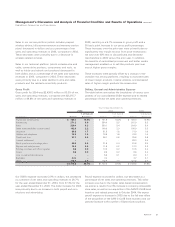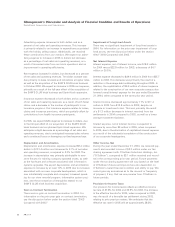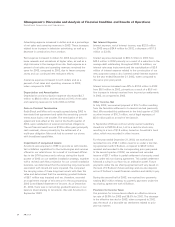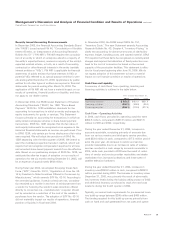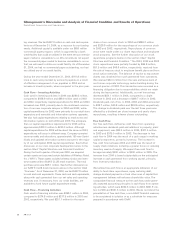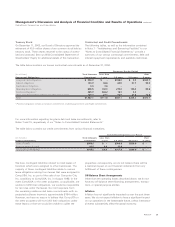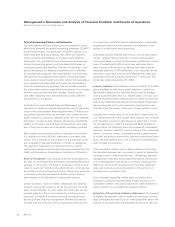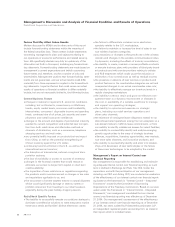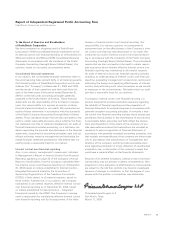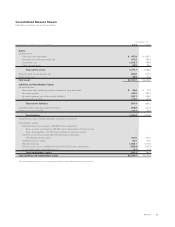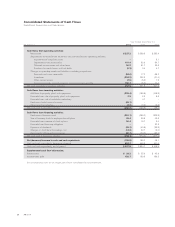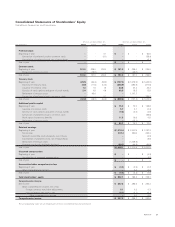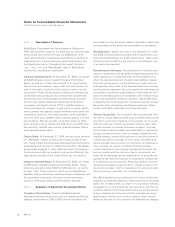Radio Shack 2004 Annual Report Download - page 33
Download and view the complete annual report
Please find page 33 of the 2004 Radio Shack annual report below. You can navigate through the pages in the report by either clicking on the pages listed below, or by using the keyword search tool below to find specific information within the annual report.
our past history and experience, as well as other specific cir-
cumstances surrounding these claims, in evaluating the
amount of liability that we should record. As additional infor-
mation becomes available, we assess the potential liability
related to our various claims and revise our estimates as
appropriate. These revisions could materially impact our
results of operations and financial position or liquidity.
We are insured for certain losses related to workers’ compen-
sation, property and other liability claims, with deductibles up
to $0.5 million per occurrence. This insurance coverage limits
our exposure for any catastrophic claims that may arise above
the deductible. We also have a self-insured health program
administered by a third party covering the majority of our
employees that participate in our health insurance programs.
We estimate the amount of our reserves for all insurance pro-
grams discussed above at the end of each reporting period.
This estimate is based on information provided by either an
independent actuarial firm or third party. The information
includes historical claims experience, demographic factors,
severity factors, and other factors we deem relevant. A 10%
change in our insurance reserves at December 31, 2004,
would have affected net income by approximately $7.5 million
for the fiscal year ended December 31, 2004. As of December
31, 2004, actual losses had not exceeded our expectations.
We are subject to periodic audits from multiple domestic and
foreign tax authorities related to income tax, sales and use tax,
personal property tax, and other forms of taxes. These audits
examine our tax positions, timing of income and deductions,
and allocation procedures across multiple jurisdictions. As part
of our evaluation of these tax issues, we establish reserves in
our consolidated financial statements based on our estimate
of current probable tax exposures. Depending on the nature
of the tax issue, it could be subject to audit over several years;
therefore, our estimated reserve balances might exist for mul-
tiple years before an issue is resolved by the taxing authority.
Additionally, we are involved in legal proceedings and gov-
ernmental inquiries associated with employment and other
matters. A reserve has been established based on our best
estimates of the potential liability in these matters. This
estimate has been developed in consultation with in-house
and outside counsel and is based upon a combination of
litigation and settlement strategies.
Although we believe that our tax and legal reserves are based
on reasonable judgments and estimates, actual results could
differ which may expose us to material gains or losses in
future periods. These actual results could materially affect
our effective tax rate, earnings, deferred tax balances and
cash in the period of resolution.
Valuation of Long-Lived Assets and Intangibles, Including
Goodwill: Long-lived assets, such as property and equipment,
are reviewed for impairment when events or changes in cir-
cumstances indicate that the carrying value of the assets
contained in our financial statements may not be recoverable.
Our evaluation of potential impairment involves comparing
the carrying value of the asset to the estimated fair value of
the asset. The fair value is determined by estimating the
future undiscounted cash flows that the asset will generate.
If the fair value calculated is less than the carrying value, we
calculate the discounted cash flows of the asset and record
an impairment loss. The impairment loss is the difference
between the fair value and the carrying value of the asset and
is recorded as a charge to earnings in the period the impair-
ment occurs. The carrying value of the asset is adjusted to
the new carrying value, and any subsequent increases in fair
value are not recorded. Additionally, if it is determined that
the estimated remaining useful life of the asset should be
decreased, the periodic depreciation expense is adjusted
based on the new carrying value of the asset.
The impairment calculation requires us to apply judgment and
estimates concerning the future cash flows, strategic plans,
useful life and discount rates. If actual results are not consis-
tent with our estimates and assumptions, we may be exposed
to additional impairment charges which could be material to
our results of operations.
We have acquired goodwill and other separately identifiable
intangibles related to business acquisitions that have occurred
during the current and prior years. The original valuation
of these intangibles is typically performed by a third-party
appraiser and may include the use of estimates that we pro-
vide concerning future profitability, cash flows and other
judgmental factors. We review our goodwill and intangible
balances on an annual basis, typically near our fiscal year
end, and whenever events or changes in circumstances
indicate the carrying value of the goodwill or intangibles
might exceed their current fair value.
The determination of fair value is based on various valuation
techniques such as discounted cash flow and other compara-
ble market analyses. These valuation techniques require us
to make estimates and assumptions regarding future prof-
itability, industry factors, planned strategic initiatives, discount
rates and others factors. If actual results or performance
of certain business units are different from our estimates,
we may be exposed to an impairment charge related to our
goodwill or intangibles. The total value of our goodwill and
intangibles at December 31, 2004, was $46.7 million.
Management’s Discussion and Analysis of Financial Condition and Results of Operations continued
RadioShack Corporation and Subsidiaries
31
AR2004


